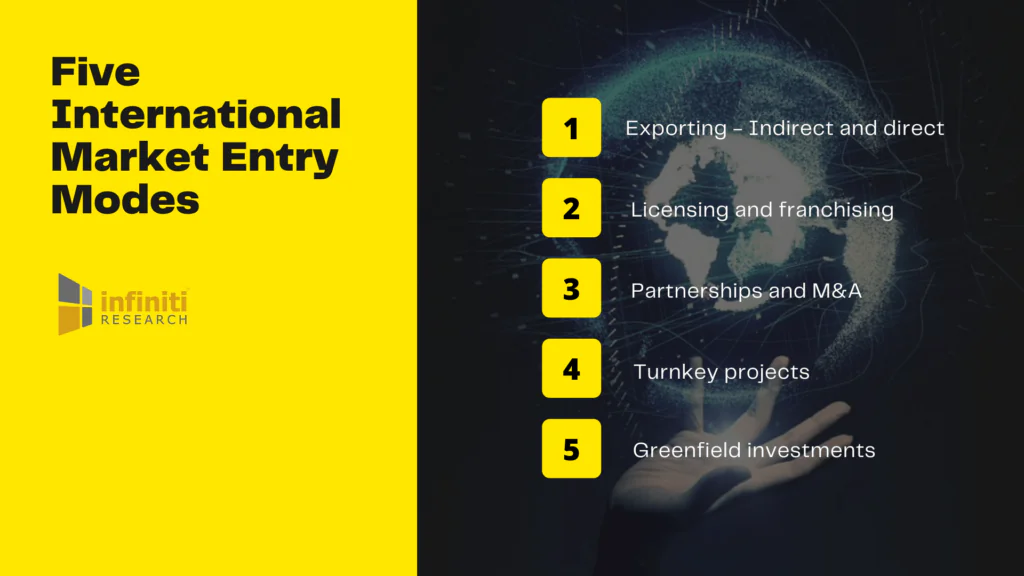A progressive, more dynamic economic environment has prompted a higher number of businesses to reconsider leveraging international market entry strategies to achieve rapid growth. However, the choice of a strategy is influenced by various internal and external factors and market entry modes that impact business growth in foreign markets. But it’s also a crucial decision that needs to be made based on in-depth research and market analysis since it impacts the company’s performance and, to a greater extent, the global supply chain.
What is the best way to enter an international market? This is one of the most baffling questions for businesses looking to expand their market footprint. Will establishing an export base or licensing products to gain experience in the new target region help businesses in the long term? Or should companies capitalize on the potential associated with a first-mover advantage and justify a bold move such as entering an alliance, making an acquisition, or even starting a new subsidiary. In this article, our experts shed light on different international market entry modes like exporting, licensing, partnerships and M&As, acquisitions, and greenfield ventures. Many companies move from exporting to licensing to a higher investment strategy, treating these choices as a learning curve. However, it is crucial to note that these international market entry modes are unique and have their own advantages and disadvantages.
Leveraging our expertise in market entry research, we offer solutions to help our clients analyze different market entry modes and build international market entry strategies. Contact us if you’re looking for similar solutions to expand your market footprint.
Types of international market entry modes
Strategies explicitly designed for market entry enable businesses to expand their portfolio and enter international market segments. However, the process of selecting the ideal market entry mode is complex. Mainly because there are many market entry modes for a company looking to expand its market footprint and sell its goods globally.

Given the complexities surrounding the selection of international market entry modes, it’s essential to understand the different strategies to be able to decide which one offers the best benefits.
Exporting – Indirect and direct
Direct exporting is one of the most common market entry modes preferred by leading market players. It is one where the parent company directly exports products to another market outside their home market. For a few players, it is the fastest mode of entry into the international markets. Whereas indirect exporting revolves around selling an organization’s goods to an intermediary who is entrusted with the responsibility of shipping and other operations required to sell the goods in international market segments.
Exporting is an easy way to enter an international market. In addition to exporting, companies can pursue more specialized international market entry modes like the ones listed below.
Licensing and franchising
Licensing is a relatively complex agreement between two businesses where one transfers the rights to market or manufacture a product to an international firm. This market entry mode works well if the purchaser of the license has a relatively large market share. But the challenge lies in convincing the foreign business to promote or deal with your products. Thus, it is a sophisticated arrangement where the business can provide goods to a large market if the new licensee has control over a large market.
We help companies identify market entry modes and build international market entry strategies to scale and amplify their impact in global markets. Request a free proposal for customized insights and solutions recommendations.
Partnerships and M&A
Partnerships and M&As have almost become a necessity when entering foreign markets. However, this market entry mode can take various forms, from a simple co-marketing arrangement to a more sophisticated strategic alliance for manufacturing. Partnering is a beneficial mode of market entry in those markets where the culture, both business and social, is fundamentally different than your own as regional partners bring local market knowledge and expertise.
Turnkey projects
Turnkey projects are beneficial for companies operating in the environmental consulting, architecture, construction & building, and engineering services business sectors. It is one of the most common market entry modes in these sectors and is also a perfect way to enter foreign markets as the other entity is usually a government or a subsidiary due to which the risks involved are much lesser.
Request free information to learn how we can help you leverage the power of innovative market research methodologies to succeed in new, international market segments.
Greenfield investments
Greenfield investments are undoubtedly the most expensive and hold the highest risk. It is mostly because the business takes the entire responsibility of building the facility and operating the business on an ongoing basis in an international market. The additional costs include the risks around changing government regulations, transportation, and shortage of skilled labor.
Given the rapid changes in market dynamics, businesses have been compelled to target international markets to achieve quick success and growth. Expanding into international market segments is crucial for both big and small ventures. Hence international market entry strategies are becoming a part of the business agenda.
However, while formulating market entry strategies, businesses must carefully analyze the different market entry modes to identify challenges and risks. In this article, our experts have shed light on a few international market entry modes to help companies combat barriers to entry and overcome challenges associated with picking the right mode.
How Infiniti Research can help
With over 17 years of experience in offering actionable market intelligence and advisory solutions, Infiniti Research has a proven track record of helping market-leading brands expand their global reach. Devising impactful international market entry strategies, reviewing micro and macroeconomic environments, analyzing the market landscape, conducting in-depth research on competitor landscapes, and building robust route-to-market strategies are a few ways we help businesses tackle their challenges. Our solutions have also helped businesses diversify their portfolios, tackle market competition, and analyze the market’s readiness for new offerings. Request a free brochure for detailed insights on different market entry modes that you must consider while expanding into a new, international market.


